How to sell Van Cleef & Arpels Jewelry
Make sure you get the best price when you resell your Van Cleef & Arpels Jewelry
Fittingly, Van Cleef and Arpels began with a love story. When Estelle Arpels, the daughter of a precious stone dealer, met Alfred Van Cleef, the son of a stonecutter, they realized they were as perfectly matched as a pair of diamond earrings.
Now, 110 years after the first boutique opened its doors, Van Cleef & Arpels has created a lasting legacy as one of the finest and most whimsical jewelry houses in the world.
But tastes and circumstances change, and we don’t need to hold on to our Van Cleef and Arpels jewelry forever.
If you are looking to sell Van Cleef jewelry and want to make sure that you get the fairest price for your piece, this blog will show you how.

Ringspo is reader supported
Ringspo is reader-supported, which means we may receive a commission if you click a link to a retailer & subsequently make a purchase.
We feature links to several retailers to help readers find the one that is the best fit for them. Find out more about how Ringspo works here.
The bottom line when selling your Van Cleef & Arpels:
The key to getting the best price when you are reselling your Van Cleef & Arpels jewelry is to work with someone who knows the true value of the jewelry and eliminate as many layers as possible between you and the buyer.
Auction houses, online marketplaces, etc act as middlemen and take a cut, reducing the amount they will pay you.
Our recommendation is Alon at The Diamond Oak – a fine jewelry specialist who will give you the best price possible, avoiding middlemen and fees. Get in touch with Alon here
Why Van Cleef & Arpels is so prized
To understand why Van Cleef jewelry is held in such high regard, it’s instructive to learn a little of the history of the brand.
Following the marriage of Estelle Arpels and Alfred Van Cleef in 1895, Estelle’s father Salomon helped Alfred begin a jewelry business the following year.
The business hit the ground running and ‘The Maison’ in Paris was founded in 1906 as a partnership Alfred and Estelle’s brother Charles (later to be joined by Estelle’s other brothers). Over the years business boomed, and the successful house soon opened boutiques in resort locales like Deauville, Vichy, Le Touquet, Nice, and Monte-Carlo, attracting in the most stylish jetsetters as clientele.
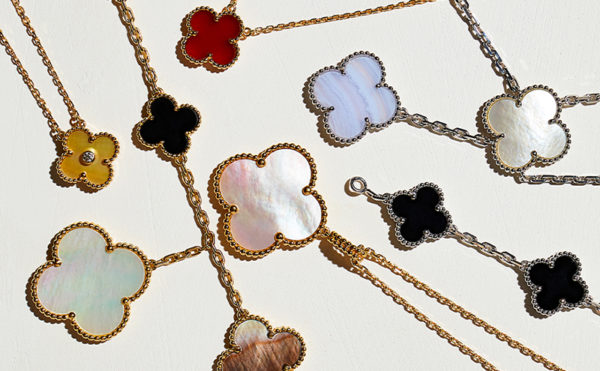
One of the first standout pieces by the company was a dazzling bracelet with red and white roses, fashioned impeccably from rubies and diamonds. It received the grand prize at the International Exposition of Modern Industrial and Decorative Arts in 1925, and helped cement their legacy for fine craftsmanship.

This superior craftsmanship soon led to the extraordinarily innovative “Mystery Set,” a technique where stones are set in such a way that no prongs are visible. The technique was patented by Van Cleef & Arpels in 1933, and the average piece of jewelry takes roughly 300 hours of labor to complete. Only a very small number of master jewelers have the expertise to execute this intricate setting. Mystery Set pieces are extremely rare; only a few are produced each year.
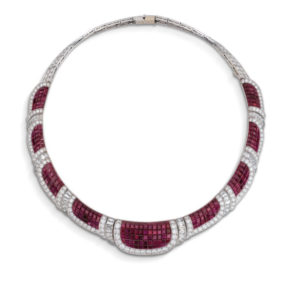
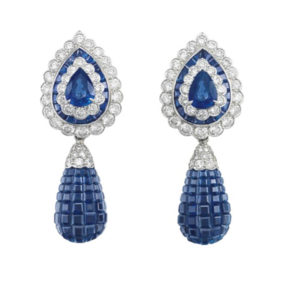
When World War II began, members of the family relocated to New York City to help grow their business across the Atlantic. The famed New York City boutique on 744 Fifth Avenue, opened in 1942, still stands to this day.
Inspired by their travels abroad to China, Japan, Thailand, Cambodia, Egypt, India, and beyond, the Arpels brothers incorporated numerous precious stones and pearls from their trips into their jewelry designs:
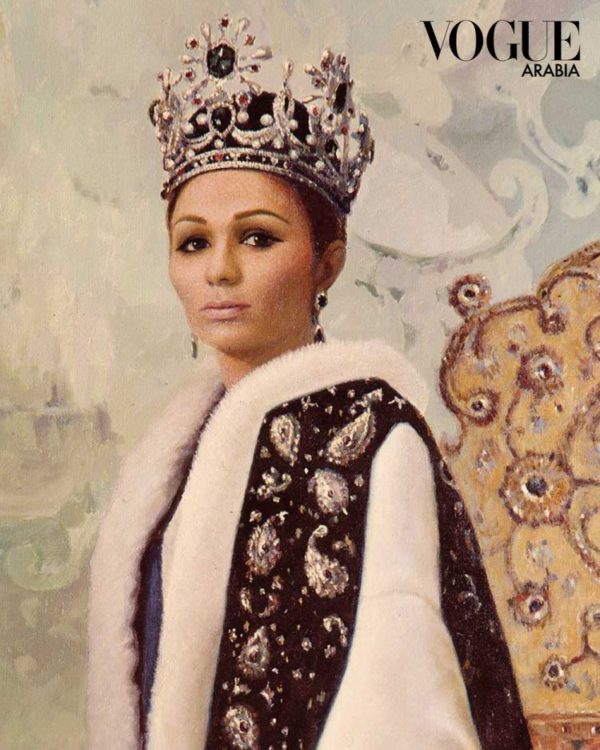
In 1966, Van Cleef & Arpels was chosen to create the jewels for the coronation of the empress of Iran, Farah Pahlavi. 1,541 stunning stones of emeralds, diamonds, rubies, and pearls were used in her pieces. Because of this experience, Persian decorative motifs and styles became a lasting source of inspiration for their work.
The brand has long been favoured by royalty such as Queen Sophia of Spain and the Duchess of Cambridge, as well as iconic figures such as Grace Kelly, Jackie Onassis, and Elizabeth Taylor.
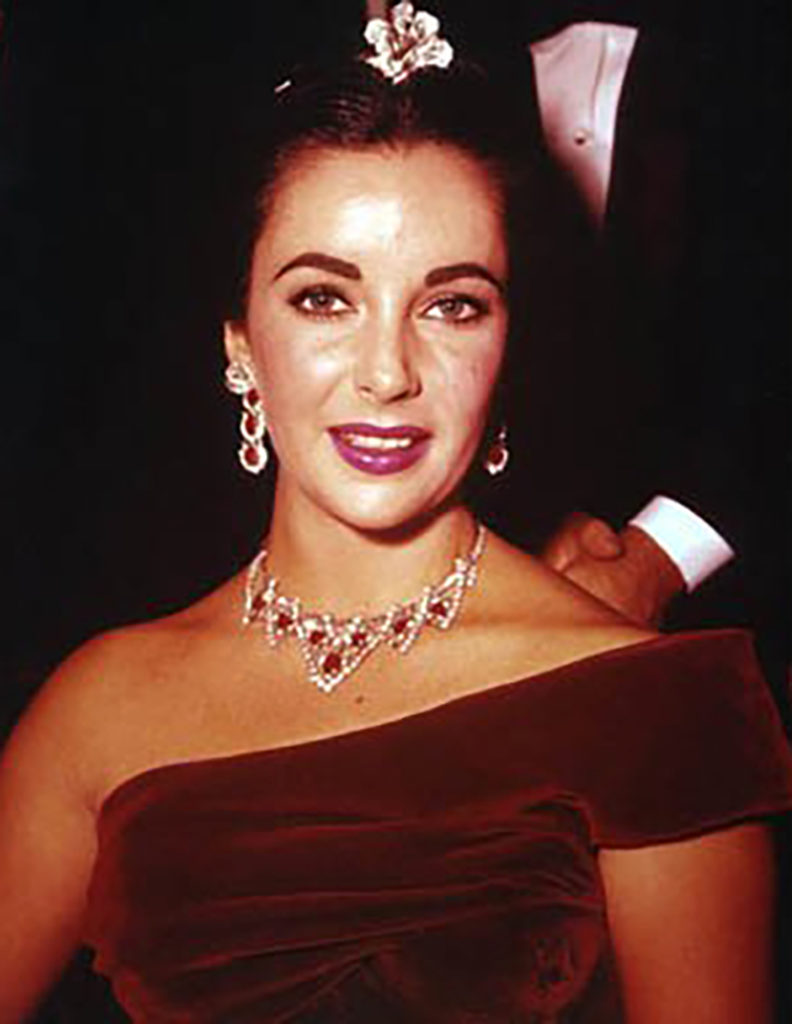

Today, Van Cleef & Arpels continues to create jewelry inspired by nature, the fantastical, and global travel, that allow jewelry lovers of all kinds to be able to experience a taste of the brand from high jewelry pieces such as the Lady Arpels Ballerine Enchantée Watch below, to the more attainable pieces that still bear that impeccable Van Cleef & Arpels craftsmanship.
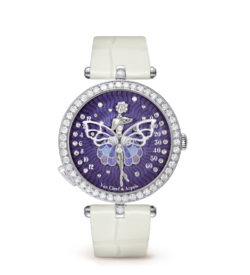
Lady Arpels Ballerina Enchantee Watch
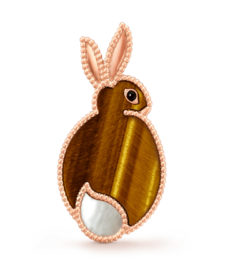
Rabbit Clip
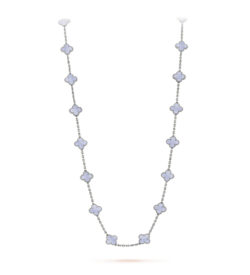
Diamond Alhambara Necklace
What type of Van Cleef & Arpels jewelry can be sold?
Over its history, Van Cleef & Arpels has produced a variety of types and styles of jewelry, and if you’re looking to sell your Van Cleef & Arpels jewelry, then that’s good news for you. No matter what piece you may own, you will be able to find an interested buyer, somewhere.
One thing to know though, is that the price you receive for your Van Cleef & Arpels jewelry when selling can be dependent on a couple of factors:
- Condition
- Provenance
Condition
All jewelry bears a history; no matter how it is cared for, if it’s worn at all, it will necessarily pick up some nicks and scratches.
Some commonly used terms to describe pre-owned jewelry are as follows:
- mint condition
- excellent condition
- good condition
- fair condition
- poor condition
When selling to a jewelry professional, it is likely that they will be intending to flip the piece by improving its condition and reselling it for a profit. That said, the better the condition of the piece, the less work will be required of the buyer; therefore, pieces in better condition should command a higher price.
Provenance
Provenance can be defined as the history of ownership of a valued object or work of art or literature.
There are multiple reasons why it is important to be able to demonstrate the provenance of your Van Cleef & Arpels jewelry:
- It proves ownership over the piece, and that it is therefore legally yours to sell.
- It proves that the piece is genuine.
Possessing things such as your receipt, the box, jewelry bag, and other appropriate accoutrements that were included with your Van Cleef & Arpels jewelry purchase will raise your buyer’s confidence in the provenance of the piece:
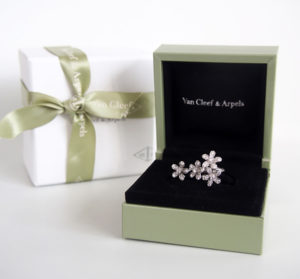
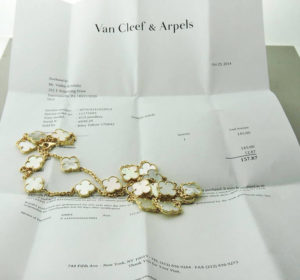
Your options when thinking about where to sell your Van Cleef & Arpels jewelry
Once you’ve made the decision to sell, it’s understandable that you would want to get the best price possible for your Van Cleef & Arpels jewelry.
But it can be hard to know where to start.
In this section, we’ll look at the different options for where you can sell, and some things to take into consideration when deciding which is the best fit for you.

When selling your Van Cleef & Arpels jewelry, there are a few things to consider:
- What you are selling
- What is more important for you – price or speed of sale
- How much you value certainty
Understanding what your Van Cleef & Arpels jewelry is worth
One of the first things to understand when you look to sell fine jewelry online is how much your jewelry is likely to be worth
You may have a jewelry appraisal stored away with a value attached to it, which you have used for insurance purposes. While there are a few types of appraisals, it’s likely that yours will list the price that it would cost to replace the item with a new, or equivalent, piece.
Unfortunately, the value on your appraisal isn’t the same as the amount that someone would actually be willing to buy the jewelry from you for. The reason being, that anyone who would buy it from you now, would then be looking to sell it as ‘used’ for lower than the price of a ‘new’ replacement item and still make a profit.
The amount that someone is actually willing to pay for an item is known as the ‘fair market value’.
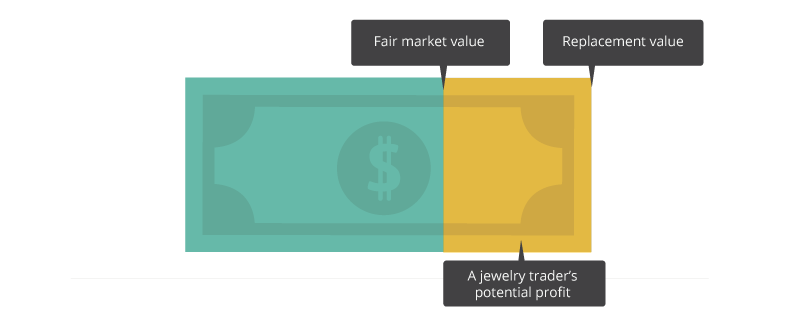
Determining the fair market value of something can be tricky, and many people look online to try and understand how much their Van Cleef & Arpels jewelry might now be going for.
One of the most famous sites for high quality vintage jewelry is 1stDibs.com, which specializes in selling from professional jewelry dealers to the public.
Many jewelry lovers enjoy browsing the wares on 1stDibs and it’s not uncommon to assume that if you see a comparable piece of jewelry being sold on there, then you may be able to receive a similar price for your own piece.
Unfortunately, however, the prices on 1stDibs are not a good guide on how much you are likely to get when you sell your jewelry, as the prices advertised are the prices that a jewelry dealer is selling them for, including making a profit once 1stDibs’ fees and all their other costs have been taken out.
However, it can be useful to get a ballpark figure of how much a jeweller may be willing to pay for your item.
For example, this vintage coral and yellow gold Alhambra pendant necklace may be listed for $7,500:
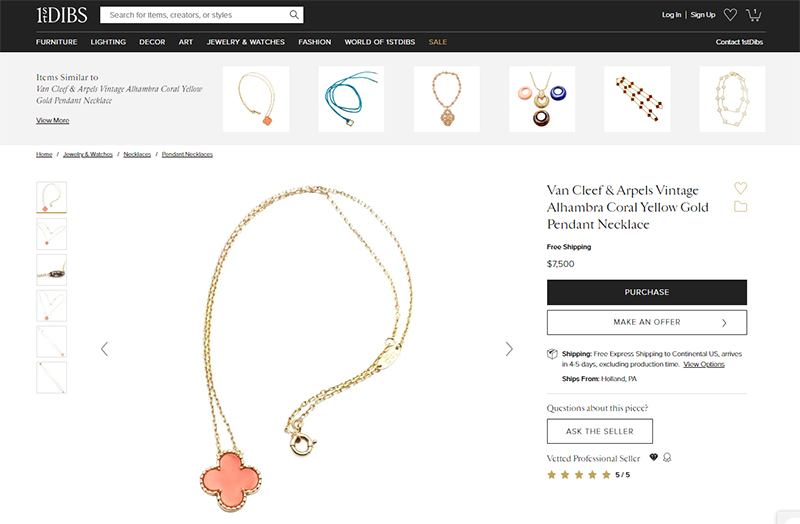
However, as with buying many vintage pieces, prices aren’t fixed and dealers are usually open to negotiation.
Underneath the ‘Purchase’ button, you can see there is a ‘make an offer’ button, which says that sellers are most likely to accept offers of 5% – 20% off the $7,500 asking price:
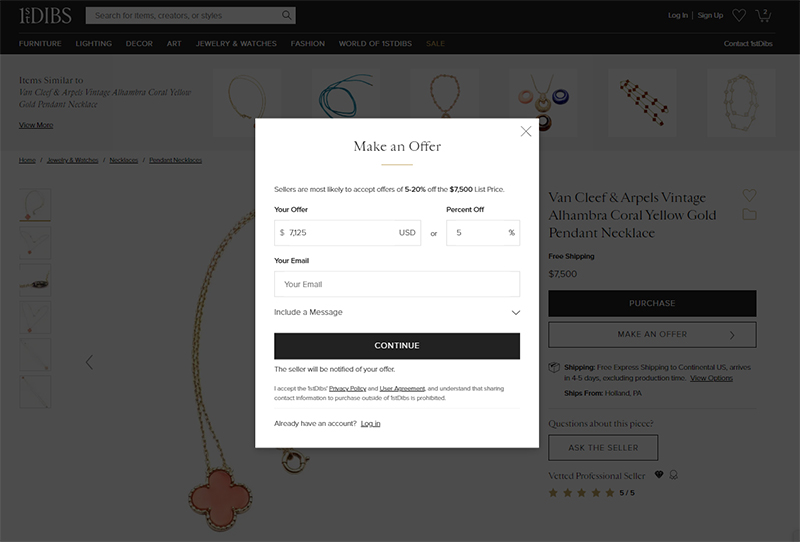
A 5% to 20% offer below the listed price is a $375 to $1,500 reduction on the original $7,500 price.
This reduces the amount that the jeweller is likely to receive for the necklace to between $7,125 and $6,000
Then 1stDibs’ commission fee needs to be taken into account. This is a 15% commission fee plus a 3% processing cost, which would reduce the price that the seller actually receives to between $5,842 – $4,920.
Most jewellers will look to buy jewelry for around half of what they are sure they can sell it for, so in order for this to make sense for the dealer, it’s likely that they would aim to buy a watch like this for around half of the $5,842-$4,920 figures.
This would mean that a jeweller is likely to pay around $2,460 – $2,921 for this particular necklace.
If you have an extremely high end or one-off piece, consider an auction house.
Van Cleef & Arpels has produced a huge range of jewelry over its 110 history, from one-off bespoke pieces for royalty, to more attainable rings and necklaces which can be purchased in their boutiques worldwide.
If you are selling an extremely rare or high-end piece, then it may make sense to use an auction house, as they can result in a higher price achieved due to the competitive nature of several bidders pushing the price up.
Two of the most well-known auction houses for jewelry are Sotheby’s and Christies:

When considering whether a traditional auction house is the right choice for you, it’s important to understand that the final ‘hammer price’ you see for past sales is not the amount that the sellers actually received.
- Sotheby’s commission for the seller is typically 10% of the final sale price
- Christies commission for a seller is also 10% of the final sale price, with an additional 2% ‘performance commission fee’ if it goes over the agreed ‘high estimate
These high-end auction houses also charge the sellers an additional 10-15% of the final sales price, which can mean that they are less willing to bid high amounts.
The other thing to consider with auction houses is the length of time that these organisations will take to sell your item.
As the snippet from an email below shows, it can take around a month for them to assess the value of an item.
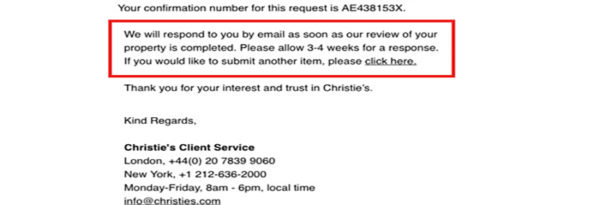
The other potential wait could be if you list your item and it doesn’t reach your desired price, in which case it will be passed on and returned to you. This uncertainty can put off some buyers who are more comfortable with a fixed price.
For the reasons listed above, if you are keen to sell your item reasonably quickly, high end auction houses are unlikely to be able to help.
But, if you are willing to wait, you have an item that fits their high requirements, and you are happy with the commission % that the auction houses charge then they could be the best solution to get a great price if your item is subject to a bidding war that drives the price up.
Selling using online auction sites
There are two types of online auction websites that deal with high quality jewellery:
- Auction sites that sell to consumers e.g. 1stDibs.com
- Auction sites that buy from consumers e.g. worthy.com
Van Cleef & Arpels and Worthy.com
Worthy.com is a marketplace which works the opposite way to 1st Dibs.
Instead of connecting professional jewelry traders to customers, it connects ordinary people who are looking to sell jewelry with a network of nearly 1,000 jewelry traders who can bid on their items.
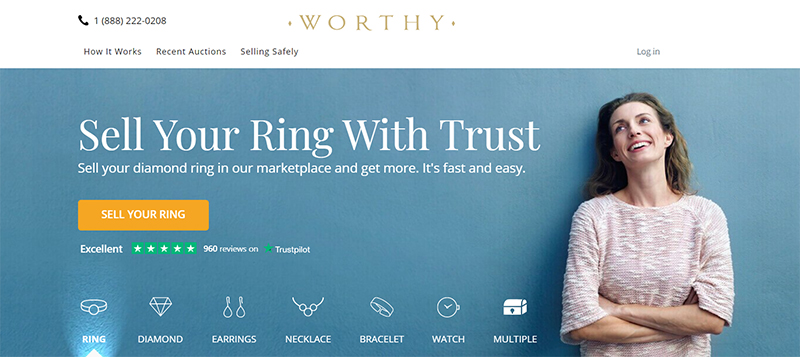
Worthy is much faster than selling through a traditional auction and it does put you in contact with a range of jewelry buyers who could bid the price of your item up, if they like it.
The cost to access these buyers is Worthy’s ‘success fee’ commission, which is only payable on the completion of the auction.
These fees are:
- Up to $5,000 = 18%
- 5,001 – 15,000 = 14%
- 15,001 – 30,000 = 12%
- 30,000 and above = 10%
Worthy can be a good option as it means that your jewelry can get out in front of as many people as possible, who will then bid against each other to increase the possible price you receive.
Van Cleef & Arpels and IdonowIdon’t.com
I do now I don’t operates on a similar business model to Worthy.com, but has a slew of bad reviews on Trustpilot with reports of them not paying sellers for the goods that have been sold.
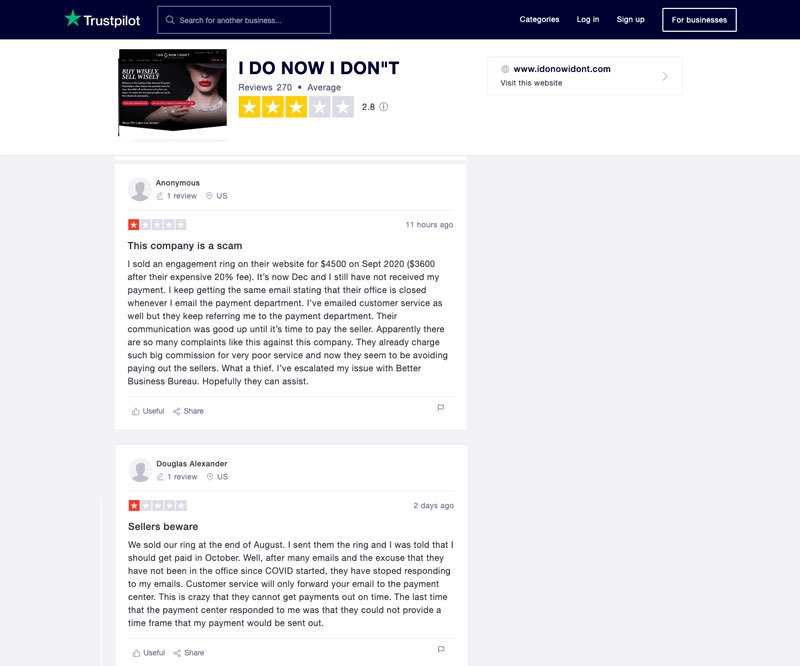
As a result I would not recommend that you use their service.
Selling Van Cleef & Arpels direct to a jewelry dealer
The best way to get the most money for your Van Cleef & Arpels jewelry is to eliminate as many layers between you and the person buying it as possible.
In essence, to talk directly to the type of people who are buying through worthy.com, but without having to pay Worthy the commission and reduce the amount you make.
Our recommendation is The Diamond Oak.
The Diamond Oak is a family run business with multiple generations in the jewelry industry, based out of the Diamond District in New York.

Best of all, working with Alon you will get a fair price extremely quickly, instead of having to wait for an auction to run its course and then pay the fees out of the sales price. Alon’s process is:
- Complete a form on The Diamond Oak’s website
- Alon will get back to you with an estimate, usually the next business day
- If you like the estimate, Alon will provide a pre-paid and insured shipping label
- Once he’s received it, Alon will check that all looks OK, and then pay straight away.

Alon of The Diamond Oak
If you have Van Cleef & Arpels jewelry that you are looking to sell, Alon at The Diamond Oak will guide you through the process and ensure that you receive the very best price possible – just click through and fill out the form and he’ll get straight back to you with an offer for you to consider.
Even if you don’t end up working with him, you will receive a guide price back extremely quickly, which can then help you understand whether you are getting a better deal through other avenues.
